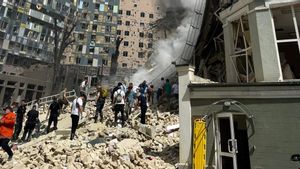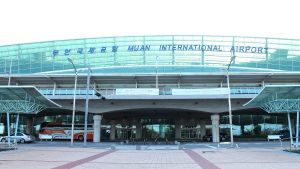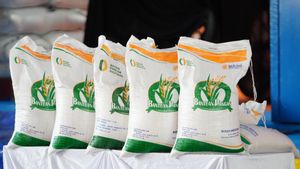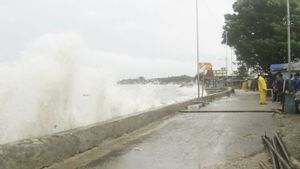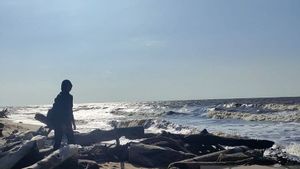JAKARTA - China's Ministry of Natural Resources said the Philippine warship BRP Sierra Madre was deliberately buried around the Ren'ai Jiao reef, the South China Sea caused environmental damage to the surrounding reefs, including coral reefs.
"Based on the findings in the distribution area, the formation of coral reefs on the reefs and the slopes of the Ren'ai Jiao lagoon has decreased drastically. This decline is very severe, especially in the waters around the banned military vessels, where many fragments of coral reefs and corals are seen as dead," said the South China Sea Ecological Center Director, Ministry of Natural Resources. China, Li Tuanjie at a press conference in Beijing, China, reported by Antara, Tuesday, July 9.
The Sierra Madre BRP is a World War II-era tank landing vessel, which was deliberately buried by the Philippines on May 9, 1999, as part of its claim of sovereignty over the Second Thomas Shoal or "Beting Ayungin" or what China calls "Ren'ai Jiao" on the disputed reefs of the Spratly Islands of China and the Philippines, as well as several other Southeast Asian countries.
The Chinese government says it has sovereign and jurisdictional rights over islands called Nanhai Zhudao in the South China Sea, consisting of Dongsha Qundao, Xisha Qundao, Zhongsha Qundao, and Nansha Qundao, better known as the Pratas Islands, Paracel Islands, Spratly Islands, and the Macclesfield Bank area.
But the Philippines puts the BRP Sierra Madre ship which the Philippines claims is in its exclusive economic zone and routinely rotates troops and sends logistics on the boat.
"The damage was caused by pollution from corrosion in the hull and peeling ship paint, waste dumped by personnel on board, and fishing activities by Filipino fishermen and personnel on board," added Li Tuanjie.
In April-June 2024, the South China Sea Ecology Center and the South China Sea Development Research Institute under the Ministry of Natural Resources conducted research on the condition of coral reefs in Ren'ai Jiao using satellite remote sensing and field observations at 18 survey stations along coral reefs.
The results of the study stated that the closure of live corals and the richness of species on the slopes of the lagoon around the ship were much lower than on slopes in other parts of the sea.
The structure of the invertebrate community in Ren'ai Jiao has become unbalanced, especially around military ships. Heavy metal content, soluble inorganic phosphorus (dissolved inorganic phosphorus or DIP), and distant oil are very high. In addition, debris including fishing nets, are widely found in the region.
Based on field evaluation and analysis, the military ship called Li Tuanjie has proven to have damaged the diversity, stability, and sustainability of coral reef ecosystems because the condition of the ship that ran aground has significantly hampered coral growth and recovery in the surrounding area.
Since 1999, the hull has been badly correlated due to carat damage. Personnel dispose of domestic waste, burn waste and waste into the waters, and engage in persistent fishing activities for a long time.
In addition, based on an analysis of remote sensing imagery, compared to conditions in 2011 and 2024, coral cover forming corals in Ren'ai Jiao decreased by around 38.2 percent. Meanwhile, the decline rate of the reef surrounding the ship within a radius of 400 meters from the ship even decreased to 87.3 percent.
Li Tuanjie also said a number of dead corals were found about 300 meters northwest of the ship. Furthermore, among the 13 ecological survey stations around the reef area, important economic-valued species commonly found in coral reef ecosystems, such as crustaceans, bivalvia, and gastropods rarely appear.
In sea-level water collected at 18 observation stations, elements of mercury, copper, zinc, and DIP were found with concentrations of 0.016 µg/L, 0.49 mg/L. 1.31 μg/L, and 5.9 μg/L, respectively.
During the field survey, a large number of Philippine fishing boats were also seen sailing around the lagoon in Ren'ai Jiao, so fish nets and fishing lines were found, fishing gear and special ropes, rubber knots, scrap metal, glass bottles, plastic bottles, and wooden sticks were found.
In particular, large fish nets with a height of about 5 meters and a length of 300 meters were also found in the waters east of the ship. The net is partly stuck in the coral, causing many corals to die scattered.
"The researchers conducted an analysis of Pearson's correlation with the three main biological parameters. The analysis showed a significant negative correlation between mercury content and coral formation and significant negative relationships between oil content and marine species as well as reef-forming corals," said Li Tuanjie.
Mercury accumulated through food chains can cause damage to coral tissue and metabolic disorders, thereby affecting coral reproduction and growth. In addition, when corals and other organisms are eaten by animals such as dolphins, turtles, and other large animals, they accidentally swallow waste so that their health is threatened.
At the same time, fishing activities carried out by Philippine fishermen and personnel on board have significantly reduced the population of organisms that are economically important.
SEE ALSO:
"Military ships illegally added to Ren'ai Jiao have caused severe damage to the diversity, stability, and sustainability of coral reef ecosystems in marine areas. It is very important for the Philippines to immediately move the ship so as to eliminate pollution sources and prevent continued further damage to coral reef ecosystems," said Li Tuanjie.
The English, Chinese, Japanese, Arabic, and French versions are automatically generated by the AI. So there may still be inaccuracies in translating, please always see Indonesian as our main language. (system supported by DigitalSiber.id)




